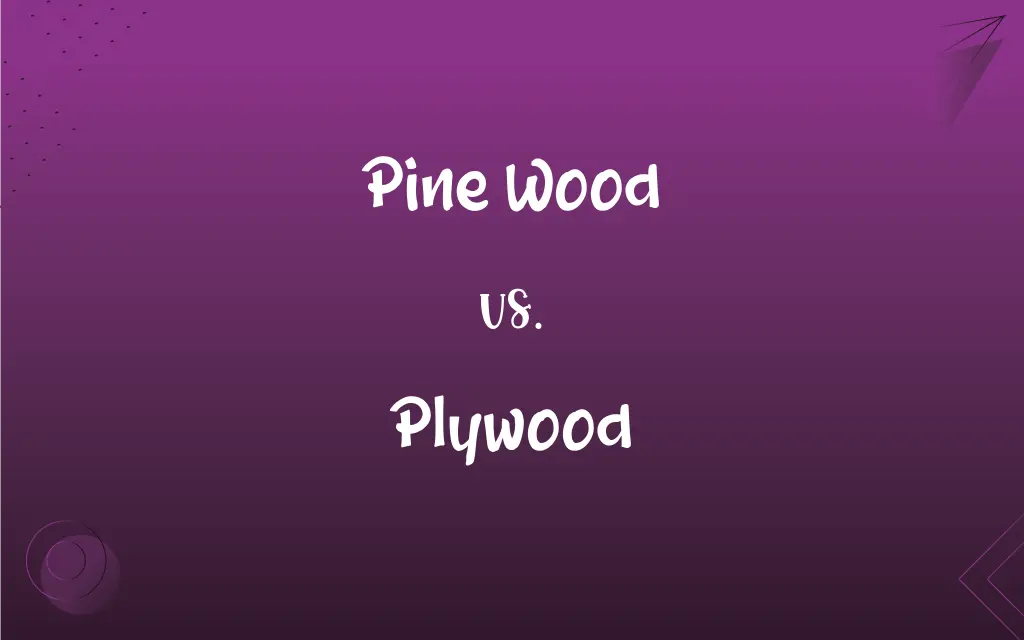Pine Wood vs. Plywood: What's the Difference?
Edited by Harlon Moss || By Janet White || Updated on November 6, 2023
"Pine Wood" refers to wood sourced from pine trees, while "Plywood" is a manufactured board made of layers of wood veneer glued together.

Key Differences
"Pine Wood" is a type of softwood that comes directly from various species of pine trees. It is known for its light color and fine grain, making it popular in furniture and construction. On the other hand, "Plywood" is not a type of wood in its natural state, but rather an engineered wood product. It is made by gluing together multiple thin layers, or "plies", of wood veneer.
The strength and characteristics of "Pine Wood" are contingent upon the specific species of pine tree from which it's derived. Being a natural wood, it can vary in density, color, and grain pattern. "Plywood", however, derives its strength not just from the wood itself but from the cross-layered structure and adhesive that binds the layers together.
"Pine Wood" can be more susceptible to dents and scratches since it is a softwood. This makes it less ideal for surfaces that receive heavy use or wear. In contrast, "Plywood", due to its layered construction, often has improved resistance to warping, cracking, and splitting, offering a more uniform strength in various directions.
In terms of aesthetics, "Pine Wood" provides a natural and organic look, often preferred for its traditional charm. "Plywood", while it can also offer an attractive appearance depending on the top veneer layer, is sometimes viewed as less "authentic" due to its manufactured nature.
Comparison Chart
Source
Derived from pine trees.
Engineered from layers of wood veneer.
ADVERTISEMENT
Nature
Natural wood.
Manufactured wood product.
Strength and Durability
Can vary; generally softer and prone to dents.
Cross-layered structure gives it strength in multiple directions.
Aesthetics
Natural and organic look.
Appearance depends on the top veneer layer.
Use
Furniture, construction, decorative pieces.
Construction, furniture, cabinetry, and other applications.
Pine Wood and Plywood Definitions
Pine Wood
Wood obtained from pine trees.
The cabin was constructed entirely from Pine Wood.
ADVERTISEMENT
Plywood
An engineered wood product made of layered veneers.
The Plywood sheets were stacked and ready for the project.
Pine Wood
A versatile wood used in various applications.
From furniture to flooring, Pine Wood is a popular choice.
Plywood
A versatile material in construction and furniture-making.
The contractor used Plywood for both the subfloor and the walls.
Pine Wood
A softwood known for its light hue.
Many prefer Pine Wood for its warm and light color.
Plywood
Wood often used for its consistent appearance and performance.
For the cabinet doors, they chose Plywood for its uniformity.
Pine Wood
Wood characterized by its straight grain pattern.
The straight grain of Pine Wood makes it ideal for woodworking.
Plywood
A board known for its cross-grain strength.
Thanks to its layered design, Plywood resists warping.
Pine Wood
Wood that is resonant and commonly used in making musical instruments.
Guitars made from Pine Wood produce a bright, clear tone.
Plywood
A product that can be finished with various veneer types.
The Plywood with a walnut veneer was perfect for the dining table.
Plywood
A structural material made of layers of wood glued together, usually with the grains of adjoining layers at right angles to each other.
Plywood
(uncountable) Construction material supplied in sheets, and made of three or more layers of wood veneer glued together, laid up with alternating layers having their grain perpendicular to each other.
After the hurricane there was a severe regional shortage of plywood, especially exterior plywood.
Plywood
(countable) A specific grade or type of this construction material.
We stock exterior plywoods, interior plywoods, and furniture plywoods.
Plywood
(transitive) To fit or block up with plywood.
Plywood
A laminate made of thin layers of wood
FAQs
How is "Plywood" manufactured?
"Plywood" is made by gluing together layers of wood veneer.
Is "Plywood" resistant to warping?
Due to its layered construction, "Plywood" often has better resistance to warping than solid woods.
What is the primary source of "Pine Wood"?
"Pine Wood" is sourced from various species of pine trees.
Can "Pine Wood" be used for flooring?
Yes, "Pine Wood" is often used for flooring due to its aesthetic appeal.
What makes "Plywood" strong?
The cross-layered structure and adhesive give "Plywood" its strength.
Is "Pine Wood" a hardwood or softwood?
"Pine Wood" is classified as a softwood.
Can "Plywood" have different finishes?
Yes, the appearance of "Plywood" can vary based on the top veneer layer.
Which has a more consistent grain, "Pine Wood" or "Plywood"?
"Plywood", being manufactured, can offer a more consistent appearance, while "Pine Wood" will have natural grain variations.
How does the cost of "Pine Wood" compare to "Plywood"?
Costs can vary, but generally, "Plywood" might be more cost-effective, especially for larger projects.
Which is considered a natural wood?
"Pine Wood" is a natural wood, while "Plywood" is a manufactured product.
How is the durability of "Plywood" in damp conditions?
Some types of "Plywood", like marine-grade, are designed for damp conditions, but others may deteriorate if exposed to moisture.
How does "Pine Wood" react to humidity?
"Pine Wood" can expand or contract with humidity changes, so it's essential to consider its use and location.
Can "Pine Wood" be stained or painted?
Yes, "Pine Wood" accepts both stains and paints well.
Is "Pine Wood" suitable for outdoor use?
While "Pine Wood" can be used outdoors, it should be treated to resist moisture and pests.
Why choose "Plywood" for cabinetry?
"Plywood" offers consistent strength, appearance, and less susceptibility to warping, making it ideal for cabinetry.
Are there environmental concerns with "Plywood" production?
Some concerns include the adhesive used and the sourcing of the veneer, but sustainable options are available.
Is "Pine Wood" sustainable?
Many sources of "Pine Wood" are sustainably harvested, but it's essential to check for certifications.
What types of projects are best suited for "Plywood"?
"Plywood" is versatile and can be used in furniture-making, construction, cabinetry, and many other projects.
What is the weight comparison between "Pine Wood" and "Plywood"?
Weight can vary based on thickness and type, but generally, "Plywood" might be heavier due to the adhesives and multiple layers.
Can "Plywood" be used as a structural material in buildings?
Yes, "Plywood" is often used as a structural sheathing in construction.
About Author
Written by
Janet WhiteJanet White has been an esteemed writer and blogger for Difference Wiki. Holding a Master's degree in Science and Medical Journalism from the prestigious Boston University, she has consistently demonstrated her expertise and passion for her field. When she's not immersed in her work, Janet relishes her time exercising, delving into a good book, and cherishing moments with friends and family.
Edited by
Harlon MossHarlon is a seasoned quality moderator and accomplished content writer for Difference Wiki. An alumnus of the prestigious University of California, he earned his degree in Computer Science. Leveraging his academic background, Harlon brings a meticulous and informed perspective to his work, ensuring content accuracy and excellence.






































































